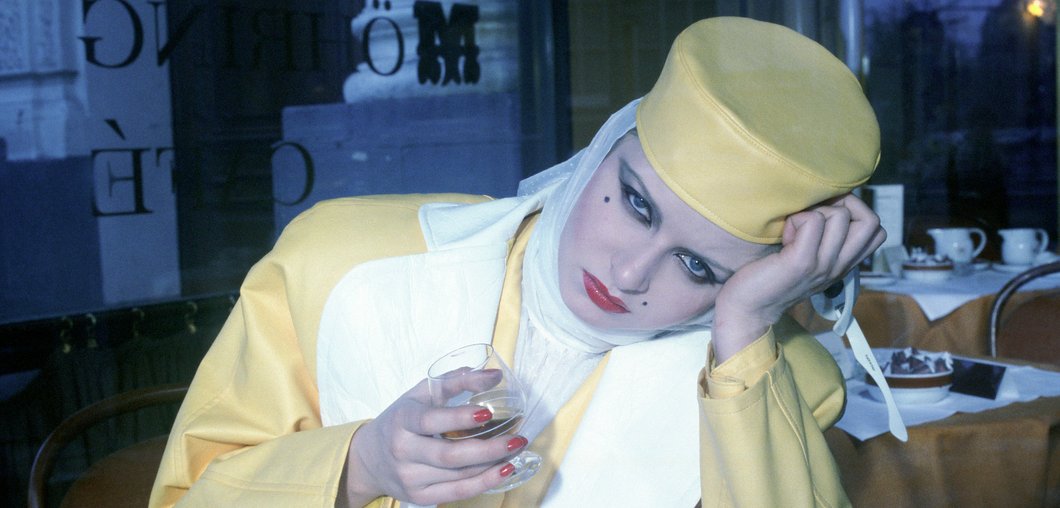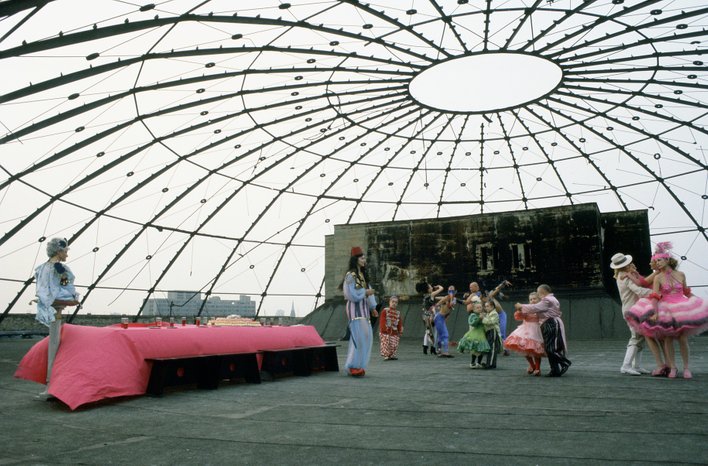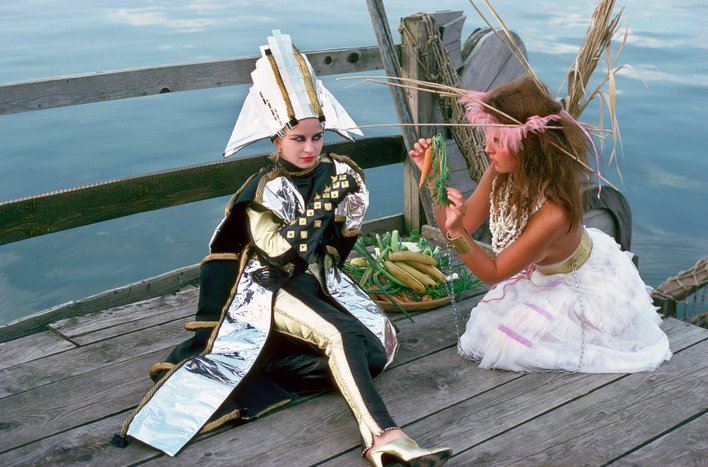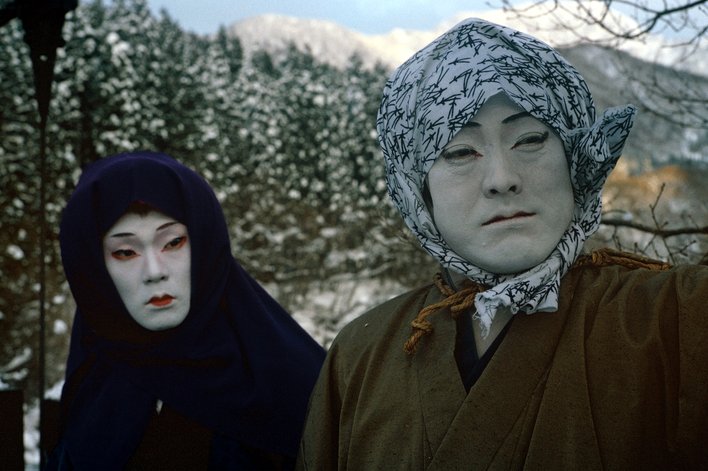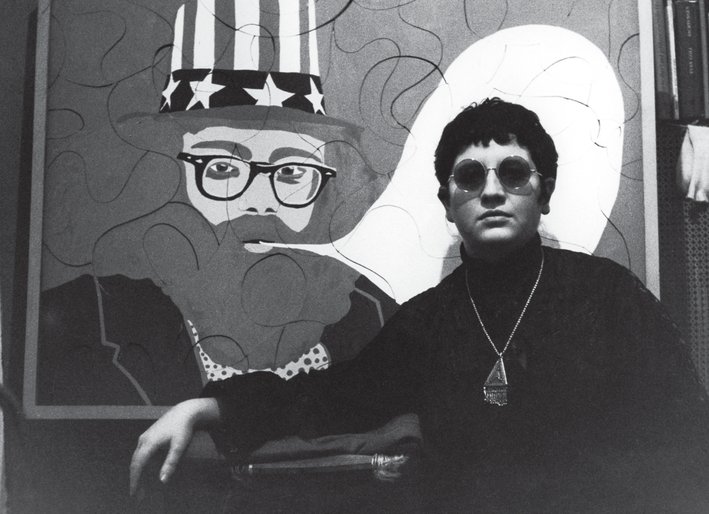Ticket of No Return
Ulrike Ottinger in conversation with Paul Clinton
MOUSSE, June 2018
Over the course of more than twenty films, Ulrike Ottinger—the first female director to film in Mongolia, who studied with Jean Rouch and filmed Yvonne Rainer roller-skating on a pirate ship has used absurdism and stylized documentary making to investigate colonialism, ethnography, sexuality, and gender. Her work is currently showing at Glasgow International 2018, following numerous exhibitions and screenings over the last decade, including at Haus der Kulturen der Welt, Berlin; CCA Singapore; and the Museum of Modern Art, New York. She talks to Paul Clinton about queerness, ideology, and feminist insubordination.
Paul Clinton The long duration of your films doesn’t make them an obvious fit for a gallery, but their theatricality and lack of linear narrative situate them oddly in cinema. How do you approach showing film in an exhibition?
Ulrike Ottinger For a long time, my films were not seen in museums, only cinemas. But over the last decades, the art world got more interested in film, with artists becoming directors.
The exhibitions involve the cooperation of different media. In Glasgow we showed three shorts in the exhibit, alongside photography, documents, and drawings. The full features are in a special cinema. But films are also an amalgam, combining media, including installation.
For 'Floating Food' [at Haus der Kulturen der Welt, 2011], I included a thematic installation so that in that large room, each film could be seen in isolation. I always make something artistic out of the problem of viewing film in a gallery. I like to have difficulties.
PC How did you select the works for Glasgow International?
UO We focused on location. I showed the Berlin Trilogy [Ticket of No Return (1979), Freak Orlando (1979), Dorian Gray in the Mirror of the Yellow Press (1984)]—central works. I made these films in Berlin between 1979 and 1983. I arrived there in ’73 to document a happening by Wolf Vostell. The capital was very different from western Germany where I grew up. Immediately, I decided to make these films, but then it took a while.
I’ve included photographs I made in Berlin. They are not stills but were taken during filming, rehearsals, some long before, when finding locations. All the scenes were staged in original Berlin places. Locations tell me a story. Sometimes it’s the history of the place, its architecture, but it can also be my fantasies. Although I’m working artistically, I don’t change much of the place, sometimes nothing. But there’s a dialogue between the locations and the staged situation.
PC You came to prominence during the New German Cinema, alongside R. W. Fassbinder, Volker Schlöndorff, et cetera. But you weren’t acknowledged in that history. Did you identify with them?
UO We were all very different, but at that time there was just a handful of filmmakers so we all knew each other. I was closest with Werner Schroeter and Fassbinder. I felt an affinity with Schroeter’s use of music because sound is important to my films. But my work has specific associations with literature and ethnography. We saw each other’s films, but I didn’t identify with them.
PC Many see your work as split into two halves: the early fiction films and later, stylized ethnographic documentaries. But Johanna d’Arc of Mongolia (1989), even if it divides between those genres, continually confuses them. What is the relationship between fiction and documentary in your work?
UO Even the fictional Berlin Trilogy is ethnography. It is an analysis, but artistically realized. I’m fascinated by why people do things. For me, there is not a big difference between devising a scenario or making a documentary. My documentaries work with collective fantasies. The Mongolian nomads do not have a naturalistic art. Their art is really stylized with a lot of fantasies, in the form of épopée, songs, and painting traditions.
Chamisso’s Shadow (2016) was made in the Bering Strait, northeast Siberia. These people too, from their religious ideas and mythologies, have a lot of fantasies relating to daily life. They have a hard existence, but fantasies are essential to explaining the world they live in. Fantasy is underestimated in documentaries.
When I was young, I was in Paris and got to study under all these great ethnographers who were also great poets.
PC You mean Michel Leiris?
UO Leiris, Claude Lévi-Strauss, Marcel Mauss, the filmmaker Jean Rouch. These were not ethnographers who questioned people in an inquisitory way, intrusively. This was important.
PC It’s not simply that documentary is a kind of fiction, although that’s there too.
UO Yes, but this also has to do with the people being filmed. There’s always a conspiracy between me behind the camera and the people in front of it: we both know that we are filming. They show me what they want to show. It’s a cooperation and a presentation. I’m not seen, but I’m visible as a visitor in the reactions of those on screen.
In Mongolia the people I filmed would suggest what we should record: “Can you hear the reindeers are coming? You should shoot this.” Or as they packed their belongings to move their yurts, they would spontaneously provide a commentary: “Now we are putting a stone on the other side of our things, to help the yak to balance.” It’s daily life, but life as they explained it to us. Normally, in a documentary, you would not show this, but I always did to foreground the process.
PC Does the development of a project differ between fiction and documentary?
UO There is no big, “I’m starting.” My half-life before involves becoming interested in several questions. Later I realize how to bring them together. I collect photographs, objects, literature, ideas. Then I start a working book, where I make a collage, drawings.
Sometimes I write dialogue. There’s often irony, even in character names, such as Lady Windermere (in Johanna). She represents connoisseurs who benefited from colonialism and the knowledge it brought them. In that film everyone is on a train, traveling on the same track: lawyers, businesspeople, artists, scientists. Despite our differences, we all have to travel on routes built by those who came before us, and this is interesting.
PC You’ve said that narratives are an unsuitable means for understanding cultures other than your own. What did you mean?
UO I think misunderstandings are more important. Narratives preserve concepts and forms from your own culture. But misunderstandings, even if sometimes they create barriers, can be productive.
While making Johanna … actress Irm Hermann was washing her clothes and put[ting] them to dry on a string. For the Mongolians, this is absolutely forbidden, because putting fabric on a string is something you do as an offering for the gods. It was an unbelievable misunderstanding but was quickly solved and became a comic scene.
PC You think those misunderstandings are less possible when you use a narrative?
UO Yes. For that film, I wrote a Mongolian epic that was adapted by two local singers and is still part of their repertoire. But the wonderful thing is that Mongolian epics leave room for little incidents of the day. They were laughing at the actors and crew because we were anxious about traveling on wild horses, so they put this into the song. When you can laugh, conflict is less likely. In this way, they made fun of the foreign and the different.
PC There is a definite queer politics in your films: the fluid sexualities and genders. But queerness is also there in your resistance toward norms, even those within feminism. Your all-female pirate film, Madame X: An Absolute Ruler (1977), is a parody of power struggles in women’s liberation, of the kind you would expect under patriarchy. What was the reaction to that film when it was released?
UO In the States, the film almost became a figurehead of the women’s movement. But this was a very ideological time, especially in Germany. One German group really hated it. Perhaps it was too early to make a comedy about conflict in women’s liberation. But I hate strict ideology because it stops you from thinking, questioning, and finding out. I like playfulness, including with gender—not limiting ourselves by being too serious.
PC Are you deliberately linking cultural and racial difference to gender and sexual difference?
UO Yes, because this is an ethnographic approach. The important thing about film is [that] it allows you to play with these structures.
PC Your films are visually opulent, fantastical, but your Berlin Trilogy satirizes the dangers of escapism and media sensationalism. Isn’t that a contradiction?
UO Cinema comes from sideshows, the circus, and these appear in my films. But attraction can be used in other ways: naively, or to persuade. My films use images ironically.
Dorian Gray in the Mirror of the Yellow Press (1984) is about indoctrination but also the history of the homunculus. I’m playing with how the media and cinema build a person, taking it back to this history. The press baron, Madame Dr. Mabuse, tries to create her own creature, Dorian Gray. The figure of the invented man recurs over time: in expressionistic films, in Fritz Lang. The media today uses unbelievable methods to manipulate, but it was always tried, except now the instruments are increasingly refined.
PC Your focus on spectacle seems to say that one can never really know other people or another culture beyond their signs and appearances. But is it also true that the absurdism in your films invites all viewers to recognize their own foreignness—the self as strange?
UO Of course—we are always the other. We are the other, and others have an interest in us. It’s a matter of viewpoint. When I visited the nomadic Mongolians, they were not used to foreigners. They asked me about cities and the animals kept there. The idea of animals kept for pleasure, not slaughter, was unfamiliar, and they couldn’t understand how I looked so well fed. One man said, “You are a great storyteller.” He thought it was a fairy tale—that’s important in my films.
I bring my workbook material on Mongolian culture, and the people I film go through it with me. They say what they have or no longer use. It’s an important start for conversation and for them to comment on your interest in their culture and the kind of environment you will create for it.
PC There’s a lot of justifiable anxiety about cultural appropriation. Is that something that concerns you?
UO I'm not making a film about a people, I’m doing a film with them. In Mongolia we worked collaboratively. There was even an elderly woman who helped me to create scenes of old rituals. Many minorities in 1980s China had big problems with the state, including the nomads. These were tensions I covered in China. The Arts—The People (1985), so there was another reason to film.
PC It’s fifty years since the May 1968 riots in Paris, which took place while you were there studying. Why are you revisiting that time in your new film?
UO I was twenty when I went to Paris. There I became friends with many postwar refugees on the literary scene and fantastic artists like Raoul Hausmann, Man Ray, Philippe Soupault, Tristan Tzara, the Surrealists. I was still a painter. Parisian Pop art had just started, and I went in that direction. The Lenbachhaus, Munich, are currently displaying some of those works.
I had no interest in films before I moved to Paris, but there I went to the cinematheque three, four times a week and got an education in world cinema. I also engaged with politics—especially the politics of colonialism. The early ’60s saw a schism within France about its colonies, around the end of the Algerian war. This was followed by Vietnam and May ’68. I’m not a fan of May ’68. It was an important protest, but significant questions were lost in ideological divisions between Maoists, Leninists, and Trotskyists. These fights took over, and it became very destructive.
PC You also look at Calligrammes—the bookstore and poems.
UO This was a wonderful shop, owned by Fritz Picard, who in 1930s Berlin had been a famous editor. He lost his library in the war, so in Paris he made this unbelievable bookshop—Librairie Calligrammes—where everybody with a name in culture went. If people came from other countries, they headed straight there: it was an information exchange.
PC And how are you approaching the film?
UO It will be poetic, like a calligram (a poem in which words are laid out to form an image). There are no interviews, but I am filming little episodes of today, and I have watched about three hundred films and gathered documents about ’60s Paris. It includes citations and a diary-like text. A combination of the old and the new, as always in my theater.
Paul Clinton 2017 © Copyright. All Rights Reserved.

